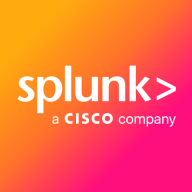

Splunk Enterprise Security and ScienceLogic are key competitors in the security and IT infrastructure monitoring arena. Splunk has a competitive edge with its advanced threat detection, comprehensive security capabilities, and well-rounded integration for multi-cloud environments. ScienceLogic shines in customizable IT infrastructure monitoring solutions, offering flexible device coverage and versatile dashboards.
Features: Splunk Enterprise Security stands out with advanced threat detection, real-time anomaly detection, and robust security analytics. It offers seamless integration and supports multi-cloud environments for effective security threat management. Additionally, it features risk-based alerting and user behavior analytics. ScienceLogic is renowned for its IT infrastructure monitoring, providing customizable dashboards, wide device support, agentless monitoring, and dynamic applications suitable for multi-tenant setups.
Room for Improvement: Splunk needs to address user interface complexities, complex clustering management, and ease of use, including improving visualizations and third-party integrations. ScienceLogic should enhance its reporting features, simplify its licensing model, improve backend documentation, and strengthen API support for better usability and integration.
Ease of Deployment and Customer Service: Both Splunk and ScienceLogic provide deployment options across on-premises, hybrid, and cloud environments. Splunk offers flexibility but may encounter initial setup complexities and scalability issues. Customer service is good, though response times could be improved. ScienceLogic is noted for simpler deployment, especially in traditional IT settings, and supports users well, though there is potential to enhance support resources and documentation.
Pricing and ROI: Splunk Enterprise Security's broad capabilities come with higher costs, but it delivers a strong ROI for large enterprises due to its efficient threat detection capabilities. ScienceLogic offers a flexible pricing model based on device tiers, making it cost-effective for infrastructure monitoring and providing significant ROI through improved operational efficiency for enterprises of varying sizes.
The return on investment is fair but often challenged by medium-sized businesses who may question its adequacy.
The documentation for Splunk Enterprise Security is outstanding. It is well-organized and easy to access.
We couldn't calculate what would have been the cost if they had actually gotten compromised; however, they were in the process, so every investment was returned immediately.
On average, my SecOps team takes probably at least a quarter of the time, if not more, to remediate security incidents with Splunk Enterprise Security compared to our previous solution.
Problems with Skylar may require longer wait times due to limited resource expertise.
I received excellent support from ScienceLogic.
We have a lab environment to test solutions before offering them to customers, ensuring everything works correctly.
We have paid for Splunk support, and we’re not on the free tier hoping for assistance; we are a significant customer and invest a lot in this service.
I have had nothing but good experiences with Splunk support, receiving timely and helpful replies.
We've had great customer success managers who have helped us navigate scaling from 600 gigs to 30 terabytes.
We currently rely on disaster recovery and backup recovery, which takes time to recover, during which you're basically blind, so I'm pushing my leadership team to switch over to a clustering environment for constant availability.
It is one of the things that separates it from other tooling, and if not, it is the most scalable solution out there.
They struggle a bit with pure virtual environments, but in terms of how much they can handle, it is pretty good.
Stability should relate to whether the platform fails, stops working, or breaks.
They test it very thoroughly before release, and our customers have Splunk running for months without issues.
Splunk has been very reliable and very consistent.
We need more SMEs, and there is no mechanism to tell us about indexer or search head issues.
While some other companies have easier APIs, using this solution demands significant expertise.
If the knowledge for implementation could be spread through articles, it would reduce this dependency.
Integrating observability and APM monitoring into the overall portfolio would be beneficial.
Improving the infrastructure behind Splunk Enterprise Security is vital—enhanced cores, CPUs, and memory should be prioritized to support better processing power.
Splunk Enterprise Security is not something that automatically picks things; you have to set up use cases, update data models, and link the right use cases to the right data models for those detections to happen.
For any future enhancements or features, such as MLTK and SOAR platform integration, we need more visibility, training, and certification for the skilled professionals who are working.
It could be cheaper.
ScienceLogic is not that expensive and is cost-effective overall.
I saw clients spend two million dollars a year just feeding data into the Splunk solution.
The platform requires significant financial investment and resources, making it expensive despite its comprehensive features.
I find it to be affordable, which is why every industry uses it.
Notably, its automation features, such as Runbook action, enable domain experts like me to execute one-click automation solutions, which contributes significantly to reducing MTTR.
The solution excels in three areas: application monitoring, server monitoring, and network performance monitoring.
The CMDB update and the automatic CMDB update are valuable.
This capability is useful for performance monitoring and issue identification.
I assess Splunk Enterprise Security's insider threat detection capabilities for helping to find unknown threats and anomalous user behavior as great.
Splunk Enterprise Security provides the foundation for unified threat detection, investigation, and response, enabling fast identification of critical issues.
| Product | Market Share (%) |
|---|---|
| Splunk Enterprise Security | 16.7% |
| ScienceLogic | 4.1% |
| Other | 79.2% |

| Company Size | Count |
|---|---|
| Small Business | 13 |
| Midsize Enterprise | 11 |
| Large Enterprise | 24 |
| Company Size | Count |
|---|---|
| Small Business | 109 |
| Midsize Enterprise | 50 |
| Large Enterprise | 263 |
ScienceLogic excels in customizable dashboards, seamless integrations, and real-time data analysis, supporting diverse IT environments with multi-tenant capabilities.
ScienceLogic provides robust infrastructure and network monitoring, catering to cloud, applications, and server environments. It supports hybrid setups, integrating with CMDB and ticketing systems while automating incident management. ScienceLogic's PowerPacks eliminate visibility gaps and its adaptable nature supports modern and legacy systems. Offering agentless monitoring, it ensures efficient operations with scalable infrastructure support and detailed reporting. However, the interface complexity and need for professional support can present usability challenges. Enhancements in reporting, application coverage, API support, and customization are desirable for improved user experience.
What are ScienceLogic's most important features?ScienceLogic is often implemented across industries requiring detailed attention to infrastructure and network monitoring. It finds utility in managing hybrid environments, integrating seamlessly with essential systems like CMDB and ticketing platforms. Its scalability and adaptability are valued in unifying complex, diverse environments under one monitoring platform.
Splunk Enterprise Security delivers powerful log management, rapid searches, and intuitive dashboards, enhancing real-time analytics and security measures. Its advanced machine learning and wide system compatibility streamline threat detection and incident response across diverse IT environments.
Splunk Enterprise Security stands out in security operations with robust features like comprehensive threat intelligence and seamless data integration. Its real-time analytics and customizable queries enable proactive threat analysis and efficient incident response. Integration with multiple third-party feeds allows detailed threat correlation and streamlined data visualization. Users find the intuitive UI and broad compatibility support efficient threat detection while reducing false positives. Despite its strengths, areas such as visualization capabilities and integration processes with cloud environments need enhancement. Users face a high learning curve, and improvements in automation, AI, documentation, and training are desired to maximize its potential.
What Are the Key Features of Splunk Enterprise Security?In specific industries like finance and healthcare, Splunk Enterprise Security is instrumental for log aggregation, SIEM functionalities, and compliance monitoring. Companies leverage its capabilities for proactive threat analysis and response, ensuring comprehensive security monitoring and integration with various tools for heightened operational intelligence.
We monitor all IT Operations Analytics reviews to prevent fraudulent reviews and keep review quality high. We do not post reviews by company employees or direct competitors. We validate each review for authenticity via cross-reference with LinkedIn, and personal follow-up with the reviewer when necessary.